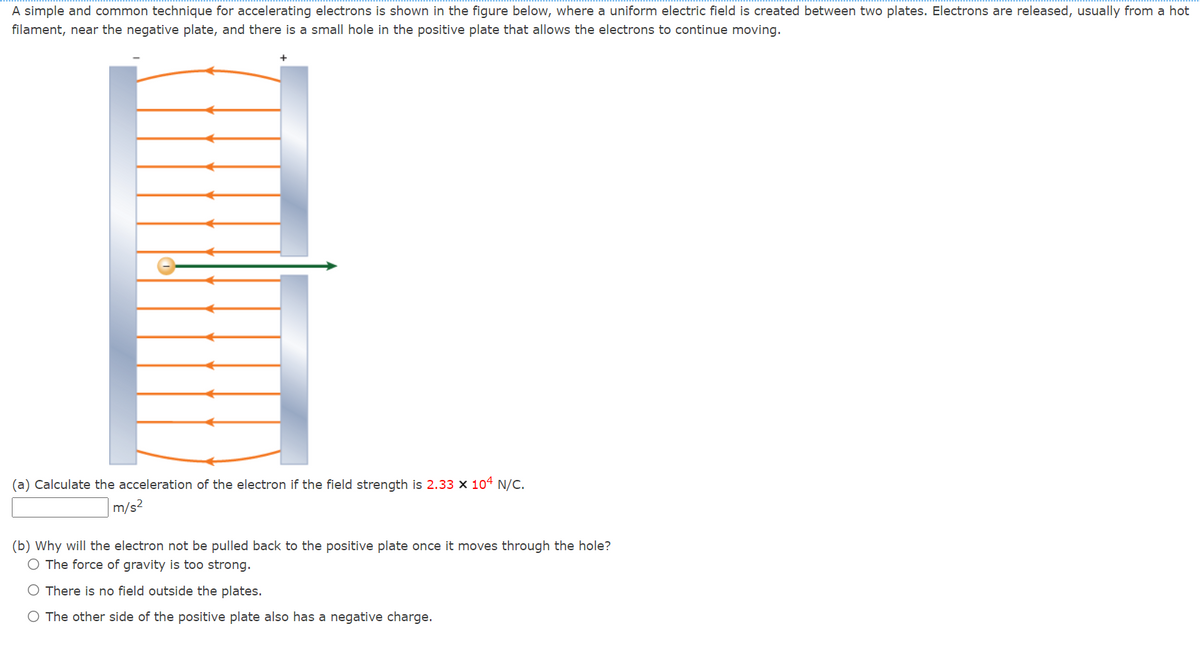A simple and common technique for accelerating electrons is shown in the figure below, where a uniform electric field is created between two plates. Electrons are re filament, near the negative plate, and there is a small hole in the positive plate that allows the electrons to continue moving.
A simple and common technique for accelerating electrons is shown in the figure below, where a uniform electric field is created between two plates. Electrons are re filament, near the negative plate, and there is a small hole in the positive plate that allows the electrons to continue moving.
Principles of Physics: A Calculus-Based Text
5th Edition
ISBN:9781133104261
Author:Raymond A. Serway, John W. Jewett
Publisher:Raymond A. Serway, John W. Jewett
Chapter19: Electric Forces And Electric Fields
Section: Chapter Questions
Problem 32P
Related questions
Question

Transcribed Image Text:A simple and common technique for accelerating electrons is shown in the figure below, where a uniform electric field is created between two plates. Electrons are released, usually from a hot
filament, near the negative plate, and there is a small hole in the positive plate that allows the electrons to continue moving.
(a) Calculate the acceleration of the electron if the field strength is 2.33 x 104 N/C.
m/s?
(b) Why will the electron not be pulled back to the positive plate once it moves through the hole?
O The force of gravity is too strong.
O There is no field outside the plates.
O The other side of the positive plate also has a negative charge.
Expert Solution
This question has been solved!
Explore an expertly crafted, step-by-step solution for a thorough understanding of key concepts.
This is a popular solution!
Trending now
This is a popular solution!
Step by step
Solved in 2 steps

Knowledge Booster
Learn more about
Need a deep-dive on the concept behind this application? Look no further. Learn more about this topic, physics and related others by exploring similar questions and additional content below.Recommended textbooks for you

Principles of Physics: A Calculus-Based Text
Physics
ISBN:
9781133104261
Author:
Raymond A. Serway, John W. Jewett
Publisher:
Cengage Learning

College Physics
Physics
ISBN:
9781305952300
Author:
Raymond A. Serway, Chris Vuille
Publisher:
Cengage Learning

Physics for Scientists and Engineers: Foundations…
Physics
ISBN:
9781133939146
Author:
Katz, Debora M.
Publisher:
Cengage Learning

Principles of Physics: A Calculus-Based Text
Physics
ISBN:
9781133104261
Author:
Raymond A. Serway, John W. Jewett
Publisher:
Cengage Learning

College Physics
Physics
ISBN:
9781305952300
Author:
Raymond A. Serway, Chris Vuille
Publisher:
Cengage Learning

Physics for Scientists and Engineers: Foundations…
Physics
ISBN:
9781133939146
Author:
Katz, Debora M.
Publisher:
Cengage Learning

College Physics
Physics
ISBN:
9781285737027
Author:
Raymond A. Serway, Chris Vuille
Publisher:
Cengage Learning

Physics for Scientists and Engineers, Technology …
Physics
ISBN:
9781305116399
Author:
Raymond A. Serway, John W. Jewett
Publisher:
Cengage Learning
